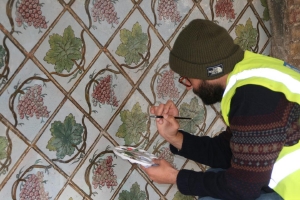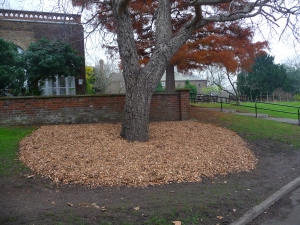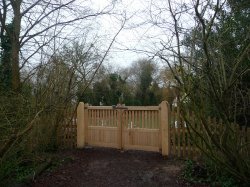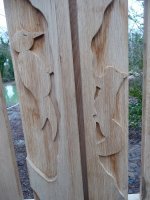2020
Conservation
 Like other owners of Holland House, Henry Edward Fox, the 4th Baron Holland, made changes to the estate. In the 1850s he created a walkway, on two levels, between the house and the summer ballroom, now the Belvedere Restaurant. The lower level runs in front of the Holland Park cafe, under the arches which provided shelter in wet weather for those heading off from the house to a party. The upper level is above the arches. The walls of both levels were ornamented with ceramic Florentine tiles which, though much restored, remain in place today. The designs of the tiles vary and include H (for Holland) with a baron's coronet, birds, bunches of grapes and fleur-de-lys. All are beautiful and well worth conserving
Like other owners of Holland House, Henry Edward Fox, the 4th Baron Holland, made changes to the estate. In the 1850s he created a walkway, on two levels, between the house and the summer ballroom, now the Belvedere Restaurant. The lower level runs in front of the Holland Park cafe, under the arches which provided shelter in wet weather for those heading off from the house to a party. The upper level is above the arches. The walls of both levels were ornamented with ceramic Florentine tiles which, though much restored, remain in place today. The designs of the tiles vary and include H (for Holland) with a baron's coronet, birds, bunches of grapes and fleur-de-lys. All are beautiful and well worth conserving
In 2004, The Friends of Holland Park made a contribution of £40,000 for conservation of the tiles on the walls of both upper and lower levels of the walkway. The work has lasted well, but further repairs were needed as these fine tiles are exposed to the elements. After a tile-by-tile assessment, Richard Rogers Conservation were commissioned to carry out conservation. Work on the lower level has been completed at a cost of £4,782, funded by The Friends. Conservation of the upper level is due to start in September 2020 and will also be funded by The Friends.
Text & photo Jennie Kettlewell
[Summer 2020]
Tree Health
 Trees that are fit are more likely to shrug off pests and diseases that might see off weaker subjects. The Friends have long sought to get ahead of the game with a proactive health programme for Holland Park's trees, intended to reduce the need for drastic remedial action and to lengthen the life of our trees.
Trees that are fit are more likely to shrug off pests and diseases that might see off weaker subjects. The Friends have long sought to get ahead of the game with a proactive health programme for Holland Park's trees, intended to reduce the need for drastic remedial action and to lengthen the life of our trees.
Each year, a number of trees are selected for treatment. These are either notable trees or trees that define an area of the park and most of those selected have evidence of disease or are generally a bit "peaky".
Around 15 trees are treated each autumn, all funded by The Friends. This involves aeration to reduce compaction, inserting non-chemical nutrients around the root plate and finishing off with a circle of mulch. The trees benefit from the nutrients and are more able to absorb them due to the aeration. Tree roots are surprisingly shallow: 80-90% are in the top 60cms of soil and 90-99% in the top 1m. These shallow roots are badly affected by compaction and by competition from grass for water and nutrients. The mulch ring discourages people from walking too close to the tree and reduces damage from machinery. The treatment works, as is evident from the improvement in the health of the tree's crown and in reduction in disease after the care they receive.
The Friends intend to continue this annual programme, as it is good news for the future of the park's trees and is part of the wider long-term tree strategy adopted by the Royal Borough of Kensington and Chelsea for its parks.
Text & photo Jennie Kettlewell
[Summer 2020]
2017
New Gates to the Wildlife Enclosure
 At last the oak gates to the Wildlife Enclosure have been installed, and they look splendid.
At last the oak gates to the Wildlife Enclosure have been installed, and they look splendid.
I say "at last" because the story starts with my 2012 visit to the Chelsea Flower Show. That is when I noticed the elegant yet robust gates displayed by exhibitor Oak Leaf Gates from Hereford. They seemed the right company to design and make the gates the Ecology Team had asked the Friends to fund.
 Many designs and lots of discussions later, we arrived at an appropriate concept. Then trustee Graham Franklin took over the project, and things speeded up, resulting in a very satisfactory conclusion.
Many designs and lots of discussions later, we arrived at an appropriate concept. Then trustee Graham Franklin took over the project, and things speeded up, resulting in a very satisfactory conclusion.
Oak Leaf select timber from certified sustainable sources in Europe. The wood is dried in a biomass boiler, burning woodchip. The power in the workshop comes from 140 solar panels. After the 5-7 year seasoning and drying process, a bark-covered section of the tree is cut into components determined by the design drawing. Then the detail cutting and hand carving starts. Only one craftsman works on the wood from start to finish, which gives a sense of ownership and real pride in the piece. Aaron James made our gates. We know that from the little bronze plaque with his name on it, fixed to one of them. Next, Ledbury-based blacksmith, Alex Wilkins, made the hinges and closure.
Throughout, the Friends worked with Holland Park Management, the Ecology Team and the crime prevention officer in the Parks Police: apart from looking attractive, the gates were designed to prevent unauthorised access.
Thanks are due to all involved, not least to Graham Franklin for seeing the project through.
Jennie Kettlewell
[Spring 2017]
